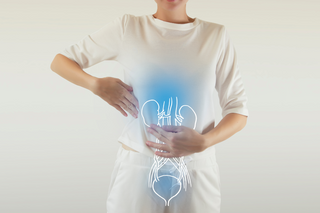The urinary system is all about balance. This system maintains homeostasis by carefully regulating the composition of bodily fluids, eliminating waste products, and ensuring that vital substances are retained or excreted in the right proportions to keep the body's internal environment stable and functional. The kidneys are primary organs of elimination and work in symphony with the blood, lymph, and adrenal glands to remove waste from the body, balance blood pressure, and maintain nutritional balance.
When working with a person's health, the urinary system is the first body system that Doctor Morse addresses, because it is so intrinsically tied to the function and health of every other body system. No matter what the imbalance, bringing the kidneys back online is essential to your health outcome. In this article we will introduce you to the anatomy and physiology of the urinary system so that you can better grasp the importance of this system in relation to whole body health and detoxification.
Take a little time to watch our discussion about the urinary system in our webinar Detox Digest: The Urinary System.
The Kidneys
The kidneys are paired organs in the upper abdominal cavity, with one on each side of the spine. They are positioned just below the rib cage, near the lower back, and protected by layers of muscle and fat and the 11th and 12th ribs. According to Traditional Chinese Medicine, discomfort in the lower back can be associated with kidney insufficiency and an imbalance in the waters of the body (Haas, Elson. 1981. Staying Healthy with the Seasons).
The kidneys filter a substantial amount of blood each day. On average, the kidneys process approximately 120 to 150 quarts (about 37 gallons)) of blood per day. This blood is continuously filtered to remove waste products, excess ions, and water, with the resulting waste forming urine, which is eventually excreted from the body.
Here is Doctor Morse’s description of kidney anatomy:
“The tops of the kidneys are opposite the 12th thoracic vertebra. They weigh approximately 5 ounces (about 141.75 g) each, and are about 4.5 inches long, 3 inches wide, and 1 inch thick. Microscopic nephrons make up the structural and functional aspects of the kidneys.
“As in most organs, and especially in glands, you find an outer portion—called the cortex and an inner portion—the medulla. Urine is formed in the nephrons, which are made up of a renal corpuscle and a venal tubule. These look like long pyramids.
“The cortex (outer) portion of the kidney houses most of the small capillary beds that are the filtering tissue between the blood and the nephron. This area is involved in filtration and reabsorption...
“These wastes (urine) travel down this pyramid (nephron tubules) into the inner portion (or medulla), where they enter common ducts called papillary ducts, which empty into the kidney reservoirs (calyces). From here the urine moves down through the ureter to the bladder.”

Other Urinary System Components
Ureters: One ureter tube is attached to the base of each kidney and sends all urine produced by the kidneys to the bladder.
Bladder: This is the holding tank for urine. There are nerves in the bladder that send a signal to the brain when the bladder is full and needs emptying.
Urethra: This is the final tube that removes urine from the bladder out of the body.
Peripheral Anatomy
The urinary tract is not an isolated system. It requires inputs, like blood and hormones, and outputs like lymphatic drainage, to function.
Adrenals: Located atop each kidney, the adrenal glands produce hormones (such as aldosterone) that regulate electrolyte and fluid balance in the body, influencing the function of the urinary system.
Blood capillaries: Supply the kidneys with oxygen and nutrients, while also allowing the removal of waste products and filtration of blood through the glomeruli to form urine.
Lymph capillaries: Drain excess interstitial fluid from the kidneys, aiding in maintaining fluid balance and removing waste products from the urinary system.
Renal Pathophysiology
The urinary system, when functioning optimally, efficiently reabsorbs and eliminates fluid from our blood as it travels through the urinary system. Now, as we delve into the pathophysiology of this system, we will trace this process step by step.
Kidney Blood Flow: Blood flows to the kidneys through the renal arteries, which branch off from the abdominal aorta, the largest artery in the body. Once inside the kidneys, the renal arteries further divide into smaller arterioles, eventually leading to the formation of a dense network of capillaries within the kidney's functional units called nephrons, where blood is filtered and processed.
Glomerular Filtration: Within the nephrons, blood is initially filtered through the glomerulus (meaning ball of yarn); capillaries within this ball are made of thin, porous epithelial tissue. Fluid containing waste, ions, glucose & amino acids pass through this lining into the capsule while larger blood cells and proteins are blocked.
Proximal Tubule Reabsorption: After glomerular filtration, the fluid enters the proximal tubule, where a massive portion of water and electrolytes are reabsorbed back into the bloodstream. As the fluid continues through the renal tubules, water is reabsorbed into the bloodstream. The amount of water reabsorbed depends on the body's hydration needs.
Loop of Henle: The remaining fluid travels through the loop of Henle, which consists of a descending and ascending limb. The loop of Henle plays a crucial role in concentrating urine and regulating water balance.
Distal Convoluted Tubule (DCT): In the distal convoluted tubule, additional reabsorption and secretion take place. Fine-tuning of electrolyte balance, particularly sodium and potassium, occurs in this segment.
Collecting Duct: The fluid continues into the collecting duct, where additional reabsorption of water and electrolytes occurs, depending on the body's hydration status. The collecting ducts from multiple nephrons merge to form larger ducts.
Renal Pelvis: The fluid, now called urine, exits the collecting ducts and enters the renal pelvis, a funnel-shaped structure that collects urine from multiple nephrons.
Ureter: From the renal pelvis, urine flows into the ureter, a muscular tube that carries it from the kidneys to the bladder.
Bladder: Urine is stored in the bladder until it is eliminated from the body through the urethra.
Erythropoietin production: Another function of the kidneys is that they produce the glycoprotein erythropoietin (EPO) in the interstitial cells located in the peritubular capillaries of the renal cortex and the outer medulla. These specialized cells are sensitive to changes in oxygen levels in the blood. When oxygen levels in the blood decrease these interstitial cells release EPO into the bloodstream. EPO then travels to the bone marrow, where it stimulates the production of red blood cells (erythropoiesis) to help increase oxygen-carrying capacity and address the oxygen deficiency in the body.
The Renal-Lymphatic Connection
The kidneys are the main eliminative organs for the Lymphatic (sewer) system. When the kidneys lose their ability to filter cellular wastes (acids) out of the body, they back up— just as sewage from any other sewer system would. This backup of acids leads to systemic acidosis and a breakdown in the proper function of this sewage system, potentially leading to systemic imbalances.
Maintaining proper kidney function supports not only the health of the urinary system, but the health of the systems that depend on this filtration to clear the body of acid buildup. This is why most of Doctor Morse’s protocols include formulas to support the health and function of the kidneys and lymphatic system.
The Third Kidney
Many holistic healers throughout time have employed what Doctor Morse refers to as the 3rd kidney when supporting kidney function. It is believed that when the kidneys are overtaxed, sweat can serve to reduce pressure within the system and take some of the load off the kidneys. There is also a connection made amongst many traditional healers that the skin is an eliminatory pathway. When the gut and kidneys are compromised, toxins will leave the body via the skin.
Urea, which is defined as the chief nitrogenous end-product of the metabolic breakdown of proteins in all mammals, is found in both urine and sweat glands.
Some studies report high urea concentrations in sweat, up to 50x that of serum, and suggest that this is evidence for a selective transport mechanism across the sweat gland, especially in patients with kidney damage, to clear the blood of high urea concentrations.
The Kidney Adrenal Connection
The adrenal glands rest on top of the: “ad” for near, and “renal” for kidney. The kidney adrenal connection involves the production and release of aldosterone from the adrenal glands, which acts on the kidneys to regulate electrolyte and fluid balance. This connection is essential for maintaining proper blood pressure and electrolyte levels in the body. For this reason, it is always suggested to pair your Kidneys & Bladder formulas with Adrenal Support.







